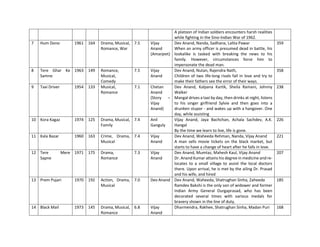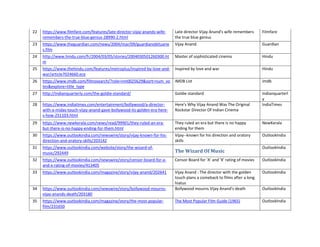The document is a tribute to the Indian filmmaker Vijay Anand, affectionately known as Goldie, highlighting his significant contributions to Bollywood cinema through his direction, screenplay writing, and song picturization. It includes a compilation of articles, interviews, and personal thoughts about his life, works, and the impact he had on the film industry. The author expresses gratitude to those who contributed to the content and seeks permission to share it, with the intent to honor Goldie's legacy among his fans.







![Great Golden Goldie
Bollywood must have dreamed about a personality who is super intellect, clear, brilliant, innocent,
methodical, studious, passionate, curious and understands what is to be delivered, why, when, where and
how. He was a super kind human being. He was slightly egoistic and more affirmative, having a clarity of
what he wanted delivered. He gave importance to relationship than money. He used to judge people
based on the various attributes and interactions, mostly on emotions and decide if he wanted to be
around such person or not.
We had such miracle happened in Bollywood, a name of the superhuman being and personality is Vijay
Anand aka Goldie. We quote him great golden Goldie.
Vijay Anand (22 January 1934 – 23 February 2004), also known as Goldie Anand, was an Indian filmmaker,
producer, screenwriter, editor and actor, who is known for acclaimed films such as Guide (1965) and Johny
Mera Naam (1970).He made most of his films for the in-house banner Navketan Films and was part of the
Anand family. He was never after award, however was motivated too on receiving few.
• Filmfare Best Director Award for Guide (1965)
• Filmfare Best Dialogue Award for Guide (1965)
• Filmfare Best Editing Award for Johnny Mera Naam (1970)
• Filmfare Best Screenplay Award for Johnny Mera Naam (1970)
• BFJA Awards as Best Editor for Johnny Mera Naam (1970)
• BFJA Awards as Best Editor for Double Cross (1973)
Vijay Anand was born in Gurdaspur, Punjab, British India to well-to-do advocate Pishori Lal Anand. He was
the youngest of the four Anand siblings, including producer and director Chetan Anand and Dev Anand,
one of the greatest and most beloved of Hindi film stars, his sister is Sheel Kanta Kapur, who is the mother
of acclaimed Indian film director Shekhar Kapur.His first marriage was with Loveleen, a marriage which
took place when Vijay Anand was influenced by Rajneesh, and Lovleen had come to interview him for
Russian Times, and wanted to marry him. This marriage was later dissolved by Rajneesh himself, when
the couple could not get along. His second marriage was with Sushma Kohli, his sister's daughter. They
have a son, Vaibhav.
Though Vijay Anand has had a career as an actor, screenwriter, editor, and producer, he will primarily be
remembered as a director. In 1957, he made his directorial debut with Nau Do Gyarah, which he shot in
40 days.
Some of his successful movies as director are Johny Mera Naam (1970), Jewel Thief (1967), Teesri Manzil
(1966), Kala Bazar (1960), Ram Balram and Rajput. Teesri Manzil, which he made for producer Nasir
Hussain, was his first non-Navketan film as a director. Some of his major films are Tere Mere Sapne (1971)
and Guide (1965). Guide, starring Dev Anand and Waheeda Rehman is Vijay Anand's most critically
acclaimed movie. It is based on R.K. Narayan's novel The Guide. Navketan attempted an international
release of a remake of Guide without much success. [citation needed]
Vijay Anand is known for his stylish song picturization, such as the numbers; "O Haseena" (Teesri Manzil
), "Kaaton Se Kheech" (Guide ) and "Honthon Mein Aisi Baat" (Jewel Thief ).
As an actor, his most memorable roles were in the films Haqeeqat (1964), Kora Kagaz (1974), (in which he
starred opposite Jaya Bachchan) and Main Tulsi Tere Aangan Ki (1978). Chor Chor was a songless thriller
in which Leena Chandavarkar was his heroine. He acted in Ghoonghroo Ki Aawaz, Double Cross and
Chhupa Rustam.
To the younger generation of the 1990s he is also known for playing detective Sam in the television series
Tehkikaat (1994).](https://image.slidesharecdn.com/great-golden-goldie-200311132303/85/Great-Golden-Goldie-8-320.jpg)














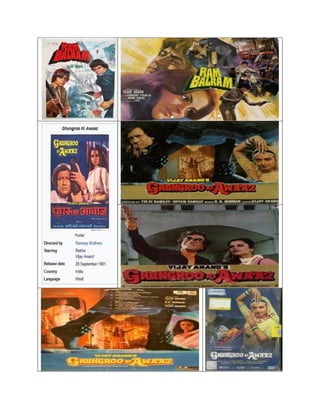

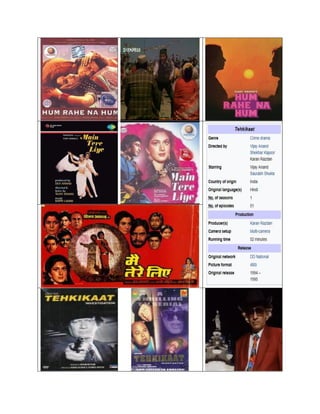









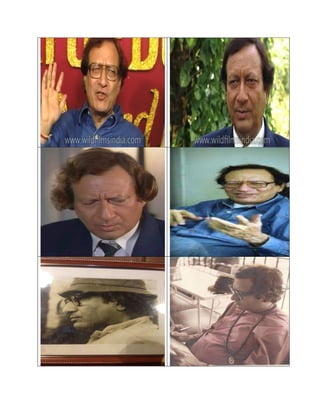



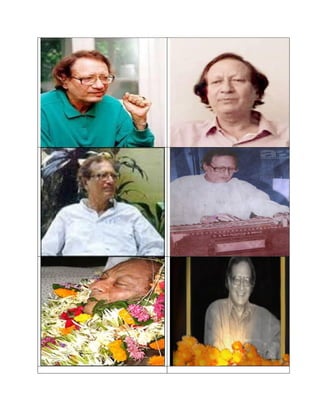
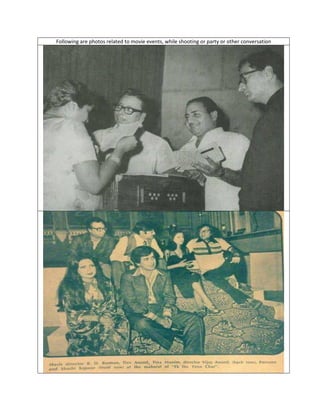

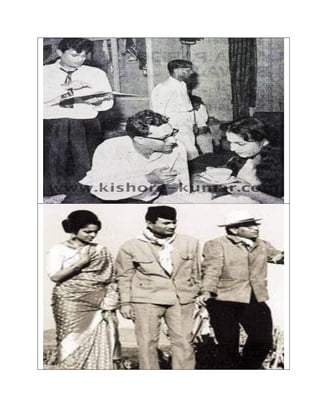














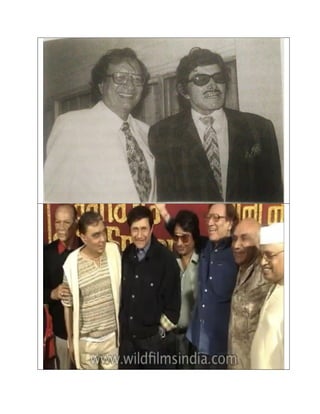



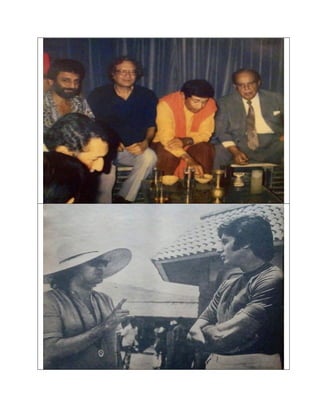



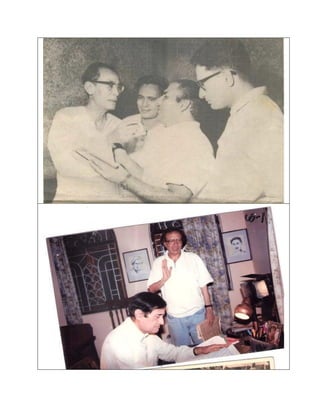

















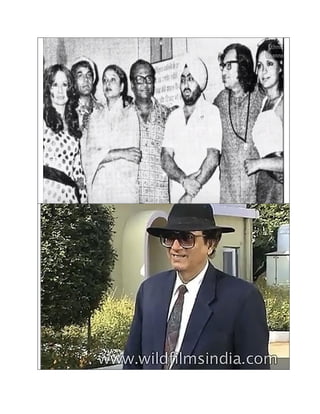








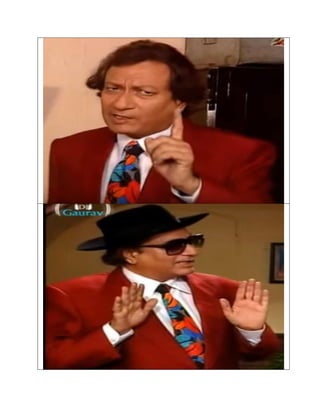












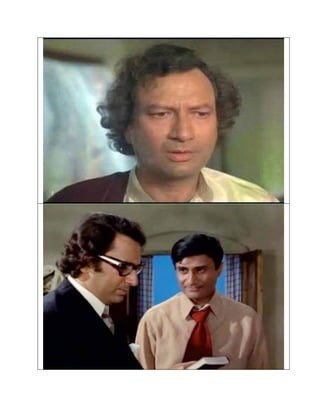




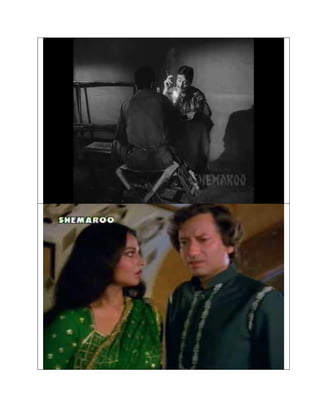








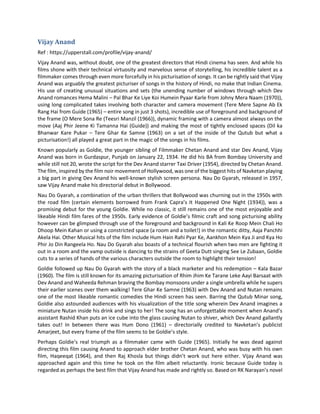







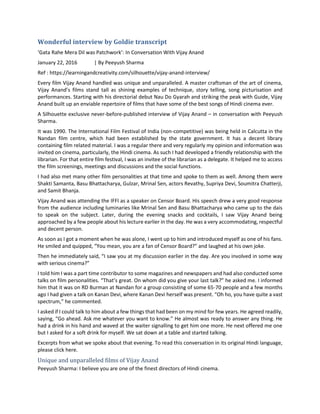







![The arrival of the choreographers Hiralal and Sohanlal brought about a very big change, and by the 1960s
they had become firmly established. They were extremely good dancers themselves, because they were
trained in classical dancing. Most directors depended on them to picturise the songs and dances. They did
not tolerate a bad director, so some directors would not even be on the set when the song was picturised.
What is the essential difference between composing a stage dance or a film dance?
Cinema choreography is very different. You cannot compose a dance in a film as you would for the stage.
Choreographers like Sachin Shankar, who came from the stage, could not succeed in films unless they
worked with a very good director who brought a strong cinematic sense and could translate the dance
into cinematic language.
I think Sachin Shankar was very good when he choreographed “a performance within a performance”—I
am thinking of “Gore Gore O Banke Chhore” (Samadhi, 1950). It takes place on a stage-like setting with
the heroines dancing and the other characters, including the hero, looking on.
Yes, but that song was for the stage, even if that stage featured in a film.
In Johny Mera Naam I worked with Sachin Shankar. When he composed the dance, he showed it to me.
He had the performers on one side and the audience on the other. We made changes together because
finally it is the camera that is the audience and the camera angles must change in every shot. So you
cannot have a strict division between performance and audience. Unlike a stage dance, the film director
has to divide the dance into shots.
If you compose for the stage, you are also confined to a small space. The dance movements are restricted
. . . usually within 20 x 20 feet. And cinema does not want to confine itself to space. It can go anywhere.
How did you work with a choreographer?
If the director is good, he uses the other artists [cameraman, composer, art director, choreographer, etc]
as tools. He appreciates their talents and finds out whether they have ideas that can enhance his own
vision. If this can happen, the entire team gives themselves into your hands. They flow with your work.
But if they find the director has no idea what he wants and just wants an entertaining dance, then the
choreographer will compose, film and edit the song.
Some choreographers have a limited understanding of editing. They want too many cuts and do not allow
the shot to be held long enough … Nowadays, film editors are in love with the rhythm. They don’t allow
you to see the faces of the heroine or hero.
You mean nowadays the rhythm determines the cut, not the narrative of the lyrics?
That’s right. Not the narrative. If the choreographers have understood the filmic situation, they do better
work than if they were left alone to conceive a dance. Otherwise they usually come up with a repertoire
of moves they have learned from their guru that may be good, but do not necessarily work for the scene.
The story comes first for good directors. When I worked with Hiralal, he knew the song had been written
for a certain situation and context in the movie. The choreographer was not really in a position to guide
me, because he had to fit his dance moves into my existing concept and narrative.
Sometimes a dance number has no lyrics. Take the snake dance in Guide. There were no words like naina
[eyes] or sawariya [beloved]. So what guides the choreographer? The director guides him. In the snake
dance I wanted the heroine to express her troubled life. You must explain the emotions that the song or
dance is meant to convey.
Can you tell me about the very first song you directed?](https://image.slidesharecdn.com/great-golden-goldie-200311132303/85/Great-Golden-Goldie-135-320.jpg)
![It was in Nau Do Gyarah. I did not have a choreographer. I did not need one. I [only] needed a
choreographer for Helen’s and Shashikala’s dance—even there the choreographer, Surya Kumar, had to
choreograph the dance in a multi-dimensional way. He knew the dance could not be seen from a static
viewpoint, as the camera was moving in many directions.
I spent my childhood with people like Zohra Sehgal, Kameshwar Sehgal, Mohan Sehgal and Guru Dutt.
They were almost living in our house. So were Balraj and Damayanti Sahni. My brother Chetan brought
them to Bombay, and until they found their own places to live in, they stayed with us. Zohra and
Kameshwar came from Uday Shankar’s dance academy and started a dance school in our Pali Hill home.
A lot of students, including Premnath, used to come to learn dancing. Prithvi Theatre people used to come
too. So I imbibed a lot by observing them. I knew what choreography was.
I am wondering if Uday Shankar indirectly inspired the film dances in the 1950s. Like Guru Dutt had Zohra
Sehgal choreograph Baazi.
Yes, they were both [Guru Dutt and Zohra Sehgal] from Uday Shankar’s dance academy and so they clicked
together.
Left to myself I would not have used theatre choreographers. They were too stagey. As I said, in earlier
times there wasn’t much emphasis on film dancing. Dancing was required as a romantic element in a song,
but it did not jump out of the story to show itself. “Look at me. I am part of the story yet not part of the
story. I am an entity in myself.”
Coming back to Nau Do Gyarah, which was the first song you shot?
“Hum hain raahi pyaar ke hum se kuchh na boliye.” Then “Kali ke roop mein chali ho dhoop mein kahaan”.
I shot those songs outdoors.
At that time I used to think a choreographer ruined songs. They interfered with the characterisation. I felt
they imposed their own personalities through their dance steps and didn’t allow the artists to express
themselves in the way they should.](https://image.slidesharecdn.com/great-golden-goldie-200311132303/85/Great-Golden-Goldie-136-320.jpg)

![TERE-GHAR-KE-SAMNE-06
What about Dev Anand?
Dev saab’s biggest problem was that he never rehearsed. He’d say: “Nahin yaar, don’t make me dance.”
And you shouldn’t make him dance because he doesn’t know how. But he had a great presence and
audiences used to see the film for his songs. He had style and other actors have copied him. Some of the
songs may look ridiculous today, but at that time they were his plus points.
In the Kala Bazar song “Khoya Khoya Chand”, Dev sings as he runs down the hill. He is madly in love and
believes his dream is coming true. So let him move his hands— white hands against dark clothes—[as] he
makes his way down the hill. It suited the scene, so once in a while you let him go.
[In the same movie] there is a scene in a train compartment. Dev Anand is sitting on the lower berth and
Waheeda Rehman is lying on the upper berth. The girl’s parents are also in the compartment. Dev saab
sings the song: “Apni to har aah ek toofaan hai/ Kya karen woh jaan kar anjaan hai/ Uparwala jaan kar
anjaan hai.” Waheeda Rehman is listening to him but she cannot move much because she’s lying on the
upper berth. There is a double meaning behind the whole situation, which is beyond choreography.
You mean the double meaning is in the line “Uparwala jaan kar anjaan hai”. The song is directed at
Waheeda, while her parents think it’s a reference to God. Very clever. Tell me about that other wonderful
song “Dil Ka Bhanwar”.
In Tere Ghar Ke Samne, Dev Anand and Nutan sing the song on the steps of the inner stairway of the
Qutab Minar. The sense that they have reached the peak of emotions is in the location, because you
cannot get higher than the Qutab Minar.
Were these conscious decisions?
Yes, certainly. Forty years have passed since I made the film. I cannot really analyse how I came to make
all these decisions. But I did feel that love was like climbing the Qutab Minar—it’s an effort. When you let
yourself go, there is no effort any more.
The film is set and shot in Delhi just after the India-China war . . . so the story of Tere Ghar Ke Samne is
about two neighbours who fight with one another. When you use the city of Delhi as a setting, you have
to have the Qutab Minar as well.
In “Dil Ka Bhanwar” you make an appearance as an extra. How did that come about?
The space was restricted and we could not get anyone else up there besides the actors, a small crew and
myself. We needed government permission to shoot inside the Qutab Minar and we were told to have a
small unit and not to use many lights. I needed two or three characters passing them on the stairs and
could not find anyone who could give the proper expression, so I thought let me do it.
It sounds like you were a very confident director from the start.
I was arrogantly confident, you know. I didn’t want to be a film director. I just took the chance. I thought
if I succeeded or failed, what the hell! I didn’t care about success or failure. I was doing my Master’s, and
thought I’d make Nau Do Gyarah and then go back to studying English literature. Unfortunately, I could
not go back to studying. I still dream I will someday.
I never cared much for a profession. Even now I don’t. I was not aware of international cinema. I respected
my seniors for their contribution to Indian cinema. But somehow I couldn’t be what they were. I did not
want actors to perform in a theatrical manner, nor did I care much for larger-than-life stories.
How old were you when you made Nau Do Gyarah?](https://image.slidesharecdn.com/great-golden-goldie-200311132303/85/Great-Golden-Goldie-138-320.jpg)
![I was 22. I made it just for the heck of it. I had written a script called Taxi Driver and my brothers made it
into a film and it did well. Of course there was more of Chetan saab in it. He didn’t respect the script that
much, but he stuck to the theme and characters and kept some of the dialogue. That gave me a lot of
confidence.
I used to write one-act plays in college and wrote scripts for the heck of it. So I wrote Nau Do Gyarah and
sold it to Shahid Lateef. He liked it very much, but he couldn’t make the film. There was another producer
called Nyaya Sharma and when he heard the story, he bought it. But he could not produce it. He was the
man who later made Kinare Kinare.
At that time, Navketan needed to produce a film. Raj Khosla, who was working at Navketan, was making
Kala Pani and could not make up his mind about what he wanted to do next. In those days people were
on the payroll and Navketan wasn’t making the kind of profit that you could wait around for a year before
making a film. So they needed a script and needed to produce a film. Our manager, Mr Prashar, told Dev
saab: “Goldie has got a very beautiful script. Shahid Lateef bought it and he is no fool. He was going to
make it, but couldn’t. So the script is just lying about. Why don’t you listen to the story?”
Dev saab said I could narrate it to him. But I was too young and arrogant, and said I would not give it to
anyone else to direct and I would direct it myself. My brother was working with all the leading directors
of the time and was shocked, and thought I was too young to direct. Dev saab said: “He hasn’t assisted
any director and hasn’t learnt the craft. He may have written a few college plays and the script for Taxi
Driver, but Chetan saab was there to direct it. How can Goldie direct? Tell him not to be foolish.” But I
refused to budge and Dev saab refused to budge …
Finally, when Dev saab heard the script and the way I had written all the details, he took a chance and
said let’s do it.
I had not learnt filmmaking from anyone. In my script I had imagined situations no one had conceived
before. I wanted my characters to exchange musical lines and not dialogue in some scenes. Luckily for me,
I had such a fantastic composer in SD Burman. He loved me so much that he encouraged me, and instead
of saying “You are very young. Don’t make a foolish mistake”, he said, “Let’s try.”
We had a song that worked like a question-and-answer scene: “Aankhon mein kya ji/ Roopehla baadal/
Baadal mein kya ji/ Kisi ka aanchal/ Aanchal mein kya ji/ Ajab si hulchul.” If these words were spoken in
dialogue, it would sound very prosaic. But if it is done musically, it becomes very interesting. No one had
done this kind of thing before.
Majrooh Sultanpuri wrote the lyrics. He was great at writing in this style. I was too young and will not say
I contributed to the song itself. It was Burman saab who made Majrooh saab write these lines. And I, like
a child, sat there very excited. They must have felt this boy has something; let’s listen to him. “Aankhon
mein kya ji/ Sunehra baadal.” I said: “Majrooh saab, it’s a moonlit night. You can’t say sunehra. Let’s try
roopehla.” Majrooh saab said: “Roopehla is a very sweet word. Shabaash! Goldie, tum achhe director
banogey. [Goldie, you’ll make a very good director.] I don’t usually listen to anyone, but that’s a good
word.”
A lot of people encouraged me when I was young.
You inspired people to think differently.
I was a catalyst. I wouldn’t say I inspired them, but my demands were unlike the usual demands. Plus I
would say no if I didn’t like something. I was very young and very proud.
Tell me something about your parents.](https://image.slidesharecdn.com/great-golden-goldie-200311132303/85/Great-Golden-Goldie-139-320.jpg)






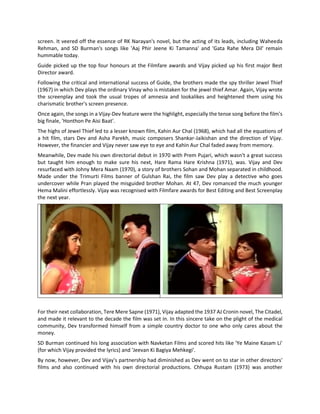







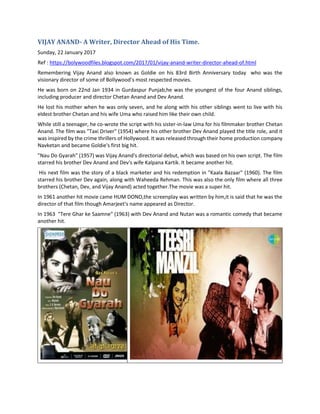

















![Vijay Anand - Master of Picturising Songs
Tuesday, 22 January 2019
Like Dev Anand, Vijay Anand also believed that songs are the soul of Indian films. He knew songs are the
glue that binds audiences to Hindi films. Close your eyes and you can see Shammi Kapoor with a scarf
around his neck, singing “Deewana Mujhsa Nahin” on a colourful hilltop, or instantly recall the smiling
faces of Dev Anand and Nutan as they sing “Dil Ka Bhanwar Kare Pukaar” on the inner stairway of the
Qutab Minar.
Few could rival his abilities when it came to writing natural and easy-flowing dialogue or picturising songs.
Most directors depended on choreographers to picturise the songs and dances. He believed that if the
song is picturised well it will bring back the audience back to the theatre. In this blog, we will look into
some of his fantastically picturised songs.
“Hum hain raahi pyaar ke hum se kuchh na boliye.” from Nau Do Gyarha was the first song he picturised.
He didn't take any choreographer in that film. At that time he used to think a choreographer ruins songs.
They interfere with the characterisation. He felt they impose their own personalities through their dance
steps and don’t allow the artists to express themselves in the way they should.
He used to say that if the director understands his subject, story and characters well, he will not
compromise in any aspect. If he is working on a film like Devdas then he has to have songs for Devdas, not
for Shammi Kapoor.
As a director, he was very particular about its music. When he was working on Jewel Thief, he discussed
with the composer. he told SD Burman: “Dada, this song is for Vyjayanthimala. I am going to use her
talents as a dancer.”
In Teesri Manzil P L Raj was the choreographer. He used to sit with the choreographer when they were
composing the songs. That time all their assistants, including Saroj Khan, who was Sohanlal’s assistant.
She would always ask him: “Goldie Saab, what do you want?”
Sometimes he would tell them they were going off track. This is not the character. I did not want any
artificiality. My characters should not become artificial when they sing. The characters are not supposed
to be dancers in the film. They are merely expressing emotion through a song.
He told in an interview that during the picturisation of Teesri Manzil's songs he told Shammi to Go wild!”
He would because he had such a tremendous sense of rhythm. He just got into the music and every fibre
of his body would dance. The only thing you had to make sure was that he did not overdo it. OK, the
character is fooling about—this much is allowed, but not beyond that. All the expressions are in the song
words: “Dekhiye… naazneen…” It’s all there, so you don’t have to do much more.
In the Kala Bazar song “Khoya Khoya Chand”, Dev sings as he runs down the hill. He is madly in love and
believes his dream is coming true. So let him move his hands— white hands against dark clothes—[as] he
makes his way down the hill. It suited the scene, so once in a while, you let him go.
In the same movie, there was a scene in a train compartment. Dev Anand is sitting on the lower berth and
Waheeda Rehman is lying on the upper berth. The girl’s parents are also in the compartment. Dev saab
sings the song: “Apni to har aah ek toofaan hai/ Kya karen woh jaan kar anjaan hai/ Uparwala jaan kar
anjaan hai.” Waheeda Rehman is listening to him but she cannot move much because she’s lying on the
upper berth. There is a double meaning behind the whole situation, which is beyond choreography.](https://image.slidesharecdn.com/great-golden-goldie-200311132303/85/Great-Golden-Goldie-172-320.jpg)



![Chetan himself, along with his wife Uma Anandand his other brother Vijay Anand. The film's music director
was S. D. Burman and the lyrics were written by Sahir Ludhianvi.The film was a super hit and it was the
film that started outdoor shooting of Bollywood films.
Dev Anand's taxi in the movie was the British made Hillman Minx, a black car with the number 1111. Such
became the popularity following the film, that the British made Hillman Minx became a vehicle of choice
as a taxi in Bombay until the 1970s
House No. 44
House No. 44 is a 1955 Hindi film directed by M. K. Burman and produced by Dev Anand for his banner
Navketan Films. The movie stars Dev Anand and Kalpana Kartik in a lead role.[1] The film is also noted for
its popular songs with music by Sachin Dev Burman, with lyrics by Sahir Ludhianvi, including "Teri Duniya
Mein Jeene Se" and "Chup Hai Dharti Chup Hain Chand Sitaare", sung by Hemant Kumar
Funtoosh
Funtoosh is a 1956 Bollywood film directed by Chetan Anand. The film stars Dev Anand, Sheila Ramani
and K.N. Singh. It was the ninth highest grossing film of 1956, and was declared a "Hit". The music of the
movie was an instant hit and songs such as "Dukhi Mann Mere" were topping Binaca Geet Mala. Other
hits were "Woh Dekhen To Unki Inayat", "Humne Kisi Pe Dore Dalne Hai", "Ae Meri Topi Palat Ke Aa" and
"Denewala Jab bhi deta Poora Chappad Phad Ke Deta". The Songs cemented the bond of SD Burman, Dev
Anand and Kishore Kumar.
Nau Do Gyarah
It was a 1957 Hindi film produced by Dev Anand. This was his brother, Vijay Anand's directorial debut.[
The film stars Dev Anand, Kalpana Kartik, Madan Puri, Shashikala and Jeevan. The film's music is by S. D.
Burman and the lyrics are by Majrooh Sultanpuri
Kala Pani
Kala Pani was a 1958 Hindi movie, produced by Dev Anand for Navketan Films and directed by Raj
Khosla.The film stars Dev Anand, Madhubala, Nalini Jaywant, Bir Sakuja and Agha. The film's music is by
Sachin Dev Burman, and the lyrics are by Majrooh Sultanpuri.
The movie won two Filmfare awards including Filmfare Best Actor Award and Filmfare Best Supporting
Actress Award.
Kala Bazar
Another Super hit film from Navketan in 1960.Written and directed by Dev's younger brother Vijay Anand,
the film starred Dev Anand, Waheeda Rehman, Vijay Anand, Chetan Anand, Nanda, S.D. Burman
composed the music, while the lyrics were penned by Shailendra.
It was noted for having several of Bollywood's stars in a cameo at the film premiere of Mother India (1957),
and it was also the only film to star the three Anand brothers together. It became a Superhit at the box
office.
Hum Dono
Hum Dono was a 1961 Hindi film produced by Dev Anand and Navketan films.The film stars Dev Anand in
a double role, and also has Nanda, Sadhana The film is also known for its music by Jaidev and became a
box office hit
Tere Ghar Ke Samne](https://image.slidesharecdn.com/great-golden-goldie-200311132303/85/Great-Golden-Goldie-176-320.jpg)
![It is a 1963 super hit film.The film, produced by Dev Anand and written and directed by his brother Vijay
Anand.The film's music is by S. D. Burman, while the lyrics have been penned by Hasrat Jaipuri.
Guide
It is a 1965 romantic drama film starring Dev Anand and Waheeda Rehman. It was directed by Vijay Anand,
who contributed to the screenplay. The film is based on the novel The Guide, by R. K. Narayan.The movie
proved memorable for its award-winning performances by the lead actors and memorable music by S. D.
Burman. The film was a box office hit upon release and considered as the Top five Classic of Bollywood.
Jewel Thief
It is a 1967 Hindi spy thriller film directed by Vijay Anand. The film stars Dev Anand, Vyjayantimala and
Ashok Kumar in the lead roles.The film became a box office hit.The music for all the songs were composed
by S. D. Burman and The lyrics for this film were by Majrooh Sultanpuri
Prem Pujari
This was the first film directed by Dev Anand.It was released in 1970 with a great hype but it did not fare
well in Box Office.The movie stars Dev Anand, Waheeda Rehman, Shatrughan Sinha, Prem Chopra, Madan
Puri and a then-unknown Amrish Puri. It has several popular songs composed by S. D. Burman.
Tere Mere Sapne
It was a 1971 film produced by Dev Anand, and written and directed by his brother Vijay Anand for
Navketan Films. The movie stars Dev, Vijay, Mumtaz and Hema Malini. The film's music is by S. D. Burman
Hare Rama Hare Krishna
It was a 1971 Indian film once again directed by Dev Anand starring himself, Mumtaz and Zeenat Aman.
The film was a hit[1] and a star-making vehicle for Zeenat Aman, who played a westernized hippie, and
won the Filmfare Best Supporting Actress Award. It aimed to have an anti-drug message,hippie Culture
and also depicts some problems associated with Westernization such as divorce.
Shareef Budmaash
It was a 1973 Bollywood action thriller film directed by Raj Khosla. The film stars Dev Anand, Hema Malini,
Shatrughan Sinha and Ajit in pivotal roles.The film was an average at the Box Office.
Heera Panna
It was a 1973 Hindi film. Written, produced and directed by Dev Anand for Navketan films, the film stars
Dev Anand, Zeenat Aman, Raakhee, Rehman, Jeevan, A.K. Hangal, Paintal and Dheeraj Kumar. The film's
music was composed by R. D. Burman.
Des Pardes
It was a 1978 Hindi film, produced and directed by Dev Anand. This family drama stars Dev Anandand
Tina Munim (in her debut film), with Ajit Khan, Pran, Amjad Khan, Shreeram Lagoo, Tom Alter, Bindu,
Prem Chopra, A. K. Hangal, Sujit Kumar, Mehmoodand Paintal in the supporting cast. For the first time,
Dev Anand chose comparatively new music director Rajesh Roshan for this film, who did full justice to his
selection as most of the songs became quite popular.](https://image.slidesharecdn.com/great-golden-goldie-200311132303/85/Great-Golden-Goldie-177-320.jpg)







![The Wizard Of Music
Ref : https://www.outlookindia.com/website/story/the-wizard-of-music/292449
On the 39th death death anniversary of Sachin Dev Burman (October 1, 1906 to October 31, 1975), a look
back at the last three years of the maestro's life Khagesh Dev Burman31 October 2014
S.D. BURMAN: THE WORLD OF HIS MUSICBY KHAGESH DEV BURMAN
RS 295 / 291 PP RUPA PUBLICATIONS
[By 1973] age had begun to impact Sachin's health adversely. He somehow managed to continue working
with his indomitable mental strength. Music was his life and he continued working tirelessly in pursuit of
his muse. The result was the release of four films in 1973 with him as the music director—Hrishikesh
Mukherjee's Abhimaan, Vijay Anand's Chhupa Rustam, Pramod Chakrabarty's Jugnu and Rajendra Singh
Bedi's Phagun....
In Abhimaan, Sachin achieved a perfect blend of music that was both artistically and commercially
successful, superimposing a popular tune on a classical base. Above all, the engrossing rapture created by
the flute fills the mind with the soft glow of moonlight. Lata sang three songs, 'Nadiya Kinare', 'Ab to hai
tumse', and 'Piya bina piya bina' for this film. All are unforgettable melodies. Who else but Lata, with her
divine voice, could have been chosen to sing the songs which were meant to overshadow the hero's voice?
Whatever it may be, whatever might have happened on screen, the melody of Kishore's solo, 'Meet na
mila re man ka' was unforgettable.
Then there are the duets—the effervescence of Lata and Rafi's 'Teri bindiya re' and the poignancy of
Kishore and Lata's memorable 'Tere mere milan ki' based on the classic Tagore song 'Jodi tere nai chini go'
Suffice it to say that even thirty-eight years later they remain the benchmark against which duets are
measured. In one fell stroke, at an age when people retire from active life and rest on their laurels, Sachin
Dev vanquished his competitors once again with his only ammunition—the classico-modern song.
More importantly, Sachin Dev Burman's continuous experimentation shattered existing systems and
customs of the world of Hindi film music. We have already talked about how he breached the 'tune first,
lyrics next' convention. Let me now turn to another custom that still held firm. It had been the custom in](https://image.slidesharecdn.com/great-golden-goldie-200311132303/85/Great-Golden-Goldie-185-320.jpg)















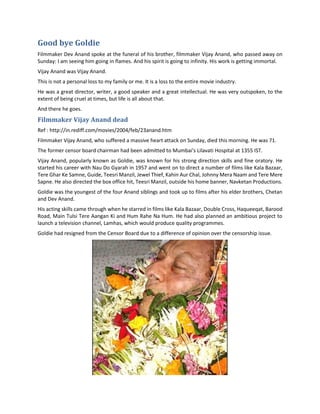


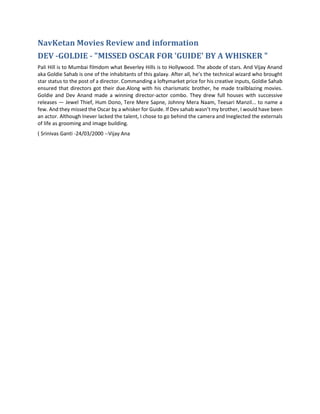


















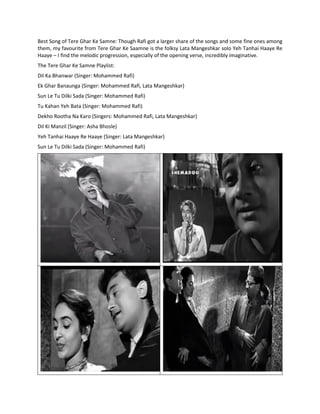




















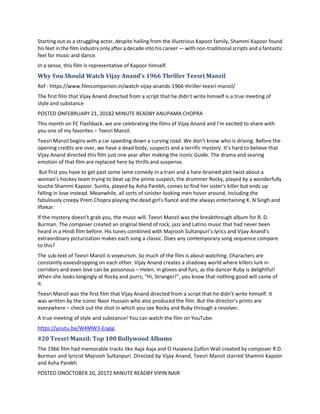

![Filmmaker Vikramaditya Motwane & Asha Parekh before screening of Teesri Manzil by SONAL PANDYA
Directed by Vijay Anand and written and conceived by Nasir Husain, Teesri Manzil (1966) is one of those
iconic Hindi films which everyone knows and loves. The film is also remembered for its groundbreaking
music by RD Burman and sublime lyrics by Majrooh Sultanpuri. Then, of course, there is the starcast –
Shammi Kapoor, Asha Parekh, Prem Chopra, Premnath and Helen. They all contributed to the film’s grand
success.
Teesri Manzil celebrated 50 years of its release in 2016 and the film was screened again at the 18th
Mumbai Film Festival on 22 October. The fun-filled screening was a trip down memory lane for many. It
was attended by actress Asha Parekh, actor Prem Chopra and many of the family members of the cast and
crew who made the film. Shammi Kapoor’s wife Neila Devi and his children, Vijay Anand’s wife, lyricist
Sultanpuri’s family, cinematographer Munir Khan’s family, and most of Husain’s children, grandchildren
and relatives were in attendance.
Filmmaker Vikramaditya Motwane was at hand to present Teesri Manzil, his favourite film. He grew up
watching Husain’s films in the 1970s but said the film had “the best music for a Hindi commercial cinema”.
Motwane also spoke to Asha Parekh before the screening. Teesri Manzil was Parekh’s third collaboration
with Husain.
Parekh was launched in Dil Deke Dekho (1959) opposite Shammi Kapoor by Husain. She recalled the
“special rapport” she had with the filmmaker. She said making the film was a lovely experience, almost
like “going on a picnic".
She talked about shooting the film with director Anand. “Working with Mr Vijay Anand was a pleasure. A
director, I feel, par excellence. He was much [ahead of his] time. I remember we were doing [the song]
‘Aaja Aaja’. I had a very bad allergy and the doctors had given me very heavy medicines which made me
sleepy. They said they will be taking a few shots here and there and I’ll be able to do it. I went on the
stage, it was antara, mukhada and music all in one shot. It was too bad!”
Parekh also revealed that she never guessed the main villain of the film, her reel sister’s murderer, until
the mystery was solved in the end. She said even in its 50th year, the film was running fresh and people
enjoyed it. Indeed, every song was met by the audience with wolf whistles and cheers, and people clapped
to the beat of 'Aaja Aaja’. The banter between Shammi Kapoor and Asha Parekh still made us laugh and
the suspense of the central killer looming large in the story held our attention even now.
The film's screening was followed up by the launch of the book, Music Masti Modernity: The Cinema Of
Nasir Husain, which is published by HarperCollins India.](https://image.slidesharecdn.com/great-golden-goldie-200311132303/85/Great-Golden-Goldie-246-320.jpg)




















![director to give his inputs in music as well. Acclaimed composer Jaidev was, incidentally, assistant music
director on the film.
Mohammed Rafi and Kishore Kumar both sang for Dev Anand while Asha Bhosle sang for Kalpana Kartik.
Geeta Dutt was brought in to voice Shashikala’s character Neeta, particularly the song ‘See Le Zuban’,
choreographed by Zohra Sehgal, credited as Zohra Saigal. A decade later, Vijay would add a similar song
in Jewel Thief (1967) that took forward the tension simmering between the characters and plot.
For the overdrawn finale of Nau Do Gyarah, Vijay heightened the tension with the ticking sound of clocks
and watches and fast cuts showing closeups of each character. Although many plot points of Nau Do
Gyarah are similar to Taxi Driver (1954), the film is decidedly different from the others that were released
that diamond year — Mother India, Pyaasa, Naya Daur, Do Ankhen Barah Haath, Tumsa Nahin Dekha and
many more.
The film, a big success all over India, solidified the Navketan banner and Vijay Anand went on to become
a stalwart of the Hindi film industry with his contributions. In the same interview with Kabir, he recalled,
“At that time, Navketan needed to produce a film. Raj Khosla, who was working at Navketan, was making
Kala Pani (1958) and could not make up his mind about what he wanted to do next.
"In those days people were on the payroll [of the studio] and Navketan wasn’t making the kind of profit
that you could wait around for a year before making a film. So they needed a script and needed to produce
a film. Our manager, Mr Prashar, told Dev saheb: “Goldie has got a very beautiful script. Shahid Lateef
bought it and he is no fool. He was going to make it, but couldn’t. So the script is just lying about. Why
don’t you listen to the story?”
Collaborators on many classics: Dev and Vijay Anand
Dev initially thought Vijay was too young to direct but his kid brother stuck to his guns about directing his
own script. Dev finally read the script and liked it and there was no looking back. A new voice emerged in
Hindi cinema with Nau Do Gyarah.
Speaking to Kabir, Vijay Anand had stated, “I was not aware of international cinema. I respected my
seniors for their contribution to Indian cinema. But somehow I couldn’t be what they were. I did not want
actors to perform in a theatrical manner, nor did I care much for larger-than-life stories.”
That, in a nutshell, was Vijay Anand, the filmmaker.](https://image.slidesharecdn.com/great-golden-goldie-200311132303/85/Great-Golden-Goldie-267-320.jpg)



![Goldie's wife-- Sushma anand speaks..........
"He directed some more films like Chhupa Rustom (1973), Ram Balram (1980) and Rajput (1982) but didn’t
meet with much success. He also happened to act Kora Kagaz(1974) and Main Tulsi Tere Aangan ki (1978),
which were huge hits. Goldie was proud of his later films Hum Rahe Na Hum (1984), a relationship saga
that featured him with Rehana Sultan and Shabana Azmi and Jaana Na Dil Se Door with newcomers. Sadly,
he couldn’t release them and that left him dejected. He’d say, “Perhaps, my time is over.”
Towards the end he had developed a heart problem. Vaibhav had assisted him in Jaana Na Hum Se Door
and then went off to attend a filmmaking course at the Lee Strasburg Institute in New York. Vaibhav
returned in January 2004. Goldie passed away in February 2004. In fact, having some knowledge of
astrology Goldie had predicted that February 2004 was a bad month for him. His only regret was that he
couldn’t do much for our son Vaibhav, who’s inherited his sensibilities. After he passed away you do tend
to get isolated. But it’s fine. I’ve taken to singing – something I was always interested in. And in my circle
of friends I often sing Tere mere sapne ab ek rang hai.."
Vijay Anand
Ref : https://www.britannica.com/biography/Vijay-Anand
Vijay Anand, (“Goldie”), Indian film director, writer, and actor (born Jan. 22, 1934, Gurdaspur, Punjab,
India—died Feb. 23, 2004, Mumbai [Bombay], India), was the visionary director of some of Bollywood’s
most respected movies and the younger brother of the legendary actor Dev Anand. He learned the craft
while working with his older brother Chetan, and the three brothers collaborated under the auspices of
the film company Navketan. Anand’s work on the script of the 1954 Bollywood film Taxi Driver led to his
first directing job, on Nau do gyarah (Nine Plus Two Makes Eleven; 1957). Of the dozens of successful
Bollywood films with which he was involved, the most acclaimed was Guide (1965), which won several
Filmfare Awards.
Guide Movie is special from many aspects, teaching us to be ambitious and contended!
Faith in god and believe in human being!
About phone call and Tere mere Sapne
It was 1992! I was working at Mumbai. I could find out residence and office number of Goldie. Post lunch
I dialed at his residence. Goldie picked up, I could recognize the voice. “Tere mere Sapne”, I replied when
Goldie asked me which his movies I like the most! When I said I like and love your movies, he asked me
Achha...aapke meri konsi film achhi lagati hai?. (o.k.; which movies do you like?)
I can not digest why was that movie termed as a flop? Nice story, strong dialogues, excellent acting, great
music and songs and emotional theme with few pieces of humour!! What does audience like? It was
extremely intelligent film; every frame is unique & sensitive! It has an excellent and Very strong story,
dialogue, screenplay, music , acting, direction!
Sapno ke tut Jane see aadmi nahi tut jata...
Apne bare me bhi kuch kaho...tum Kya ho...doctory ke peshe par ek dhabba. Jaganath Kothari, mbbs
Bombay mrcog london...Jinake bharose unko jindagi ki ummid ho sakati hai wo nasheme chur pada hai...
Tere mere sapne is one of the most sensitive films in Bollywood produced and directed by Vijay Anand,
with excellent acting by all actors including Vijay Anand himself and Dev Anand, and one of the best roles
delivered by Mumtaz.](https://image.slidesharecdn.com/great-golden-goldie-200311132303/85/Great-Golden-Goldie-271-320.jpg)




